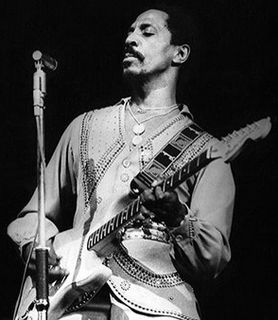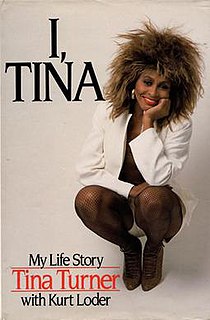
Izear Luster "Ike" Turner Jr. was an American musician, bandleader, songwriter, record producer, and talent scout. An early pioneer of 1950s rock and roll, he is best known for his work in the 1960s and 1970s with his then-wife Tina Turner as the leader of the Ike & Tina Turner Revue.

Tina Turner is an American-born Swiss singer and actress. Widely referred to as the "Queen of Rock 'n' Roll", she rose to prominence as the lead singer of the Ike and Tina Turner before launching a successful career as a solo performer.

Mary Kathleen Turner is an American actress. Known for her distinctive voice, Turner has won two Golden Globe Awards and has been nominated for an Academy Award and two Tony Awards.

Ike & Tina Turner were an American musical duo consisting of husband and wife Ike Turner and Tina Turner. From 1960 to 1976, they performed live as the Ike & Tina Turner Revue, supported by Ike Turner's band the Kings of Rhythm and backing vocalists called the Ikettes. The Ike & Tina Turner Revue was regarded as "one of the most potent live acts on the R&B circuit."

What's Love Got to Do with It is the eighth solo studio album by Tina Turner, released on June 15, 1993, by Parlophone. It served as the soundtrack album for the 1993 Tina Turner biographical film of the same name, which was released by Touchstone Pictures that same year.

"River Deep – Mountain High" is a song by Ike & Tina Turner released as the title track to their 1966 studio album on Philles Records. Produced by Phil Spector and written by Spector, Jeff Barry and Ellie Greenwich. Rolling Stone ranked "River Deep – Mountain High" No. 33 on their list of the 500 Greatest Songs of All Time. NME ranked it No. 37 on their list of the 500 Greatest Songs of All Time. The Rock and Roll Hall of Fame added it to the list of the 500 Songs That Shaped Rock and Roll. The song was inducted into the Grammy Hall of Fame in 1999.

Nutbush is a rural unincorporated community in Haywood County, Tennessee, United States, in the western part of that state. It was established in the early 19th century by European-American settlers who brought along or bought enslaved African Americans to develop the area's cotton plantations. The African Americans built houses and churches that still stand.

"Nutbush City Limits" is a semi-autobiographical song written by Tina Turner which commemorates her rural hometown of Nutbush in Haywood County, Tennessee, United States. Originally released as a single on United Artists Records in August 1973, it is one of the last hits that husband-wife R&B duo Ike & Tina Turner released together.

I, Tina: My Life Story is a 1986 autobiography by Tina Turner, co-written by MTV news correspondent and music critic Kurt Loder. The book was reissued by Dey Street Books in 2010.

The following is a comprehensive discography of the American-born Swiss singer Tina Turner. Turner's overall discography consists of ten studio albums, two live albums, two soundtracks, and five compilation albums.
"I Might Have Been Queen" is a song written for Tina Turner as the first track on her highly successful Private Dancer album, and later included as a re-mixed version, with an additional lyric added to the bridge, on her What's Love Got to Do With It soundtrack album.

"A Fool in Love" is the debut single by R&B duo Ike & Tina Turner. It was released on Sue Records in 1960. The song is Tina Turner's first professional release although she had been recording with Ike Turner and his Kings of Rhythm since 1958. It was the first national hit record for bandleader Ike Turner since the number-one R&B hit "Rocket 88" in 1951, for which he did not receive proper credit.

Tina!: 50th Anniversary Tour was the eleventh concert tour by singer Tina Turner. It was the first tour by Turner in eight years, following her record-breaking "Twenty Four Seven Tour". The trek marked the singer's 50th year in music—since joining Ike Turner and the Kings of Rhythm in St. Louis, Missouri. In conjunction with the tour, Turner released the compilation album, Tina!. Beginning October 2008, the tour performed in over 40 cities throughout North America and Europe.

The Collected Recordings: Sixties to Nineties is a 16-bit digitally remastered three-disc compilation album by American singer Tina Turner. The 48-track compilation was released in the United States on November 15, 1994, by Capitol Records.

Tina: The Tina Turner Musical is a jukebox musical featuring the music of Tina Turner and depicting her life from her humble beginnings in Nutbush, Tennessee, to her transformation into a rock 'n roll star. Directed by Phyllida Lloyd with a book by Katori Hall, Frank Ketelaar, and Kees Prins, the musical had its world premiere on 17 April 2018 at the Aldwych Theatre in London. The Broadway production opened on 7 November 2019.
Bolic Sound Studios was a recording studio complex in Inglewood, California. It was built by musician Ike Turner in 1970, and remained in operation until it burned down in 1981.

Nutbush City Limits is a studio album by R&B duo Ike & Tina Turner released on United Artist Records in 1973. The album is noted for the hit single "Nutbush City Limits" which became a staple in their live shows.

Takin' Back My Name: The Confessions of Ike Turner is a 1999 autobiography by American musician Ike Turner with British writer Nigel Cawthorne.
Alline Bullock was an American songwriter and the older sister of singer Tina Turner. Bullock was the one-time manager of the girl group the Ikettes. She wrote songs for Ike & Tina Turner as well as their band the Kings of Rhythm, most notably "Funkier Than a Mosquita's Tweeter" which was covered by Nina Simone.
Marcy Thomas, also known as Lyrica Garrett is an American singer and actress. She started off her career as an Ikette in the Ike & Tina Turner Revue in the 1970s. She also sang with The Undisputed Truth, Rick James, and Johnny "Guitar" Watson. As an actress, she toured with The Wiz production and was later featured on the VH1 reality show Love & Hip Hop: Hollywood with her daughter Lyrica Anderson.
















